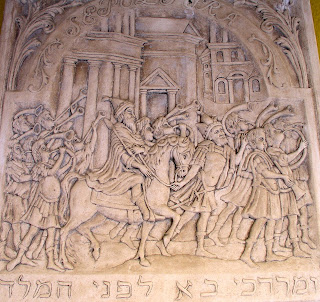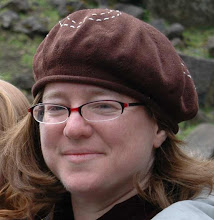
Once conversos left the Iberian Peninsula and were free to practice Judaism openly, Purim remained an important holiday. The Jewish Historical Museum in Amsterdam contains many fine examples of richly illustrated Megillot, one of which is featured in the video below. The reading is from the Portuguese Esnoga.
 Gravestones from the Jewish Atlantic World also feature scenes from the story of Esther. It was not uncommon for stones to feature Biblical scenes, particularly ones related to the name of the deceased. The detail of the stone at the top of the page is from the gravestone of Mordechay Hisquiau Namias de Crasto (1716) Beit Haim Blenheim, Curaçao. For the full stone and the inscription, see below. A similar scene appears in Beth Haim at Ouderkerk aan de Amstel on the stone of Moses de Mordechai Senior (1730) (left).
Gravestones from the Jewish Atlantic World also feature scenes from the story of Esther. It was not uncommon for stones to feature Biblical scenes, particularly ones related to the name of the deceased. The detail of the stone at the top of the page is from the gravestone of Mordechay Hisquiau Namias de Crasto (1716) Beit Haim Blenheim, Curaçao. For the full stone and the inscription, see below. A similar scene appears in Beth Haim at Ouderkerk aan de Amstel on the stone of Moses de Mordechai Senior (1730) (left).Classroom Resource:Gravestone of Mordechay Hisquiau Namias de Crasto (1716) Beit Haim Blenheim, Curaçao. This is one of the finest examples of gravestone art from the Jewish Atlantic World. Ask students what they think the different images mean and why they belong together on one stone. Why do you think the carver (or the family who requested the stone) chose this particular scene from the book of Esther?
Questions for Readers:
Do these stones surprise you, and if so how?



1 comments:
I think I finally got Word to stop randomly inverting the order of my Hebrew letters in the Classroom resource above. Does anyone know how to prevent this problem?? In any case, my apologies.
Post a Comment